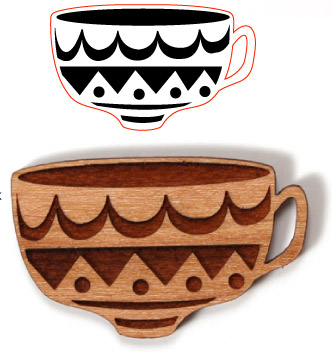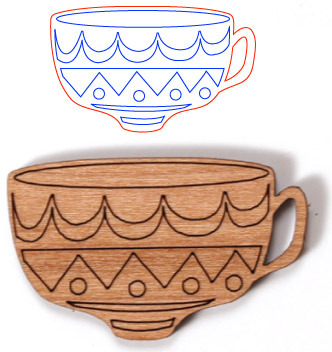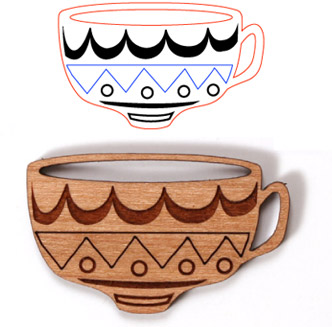what is laser cutting?
Laser cutting is the process of using a powerful laser to cut and/or engrave items from flat sheets of material like plastic, wood and many other materials.
Using the laser cutting process you can make things like signage, jewellery, prototype pieces as well as mass production jobs.
The Laser cutter works by directing a high powered laser beam very precisely at the chosen material to either engrave, mark or cut right through. When cutting, the laser beam burns away the material leaving you with the cutout shape that you have specified in your vector file. The cutting beam is very thin (typically around 0.1mm) and precise resulting in incredibly detailed and accurate cuts. By reducing the beam power you can mark the surface of the material, this is known as etching or engraving and can give some stunning effects on wood and plastic.
Traditionally laser cutting has been used by engineers to cut complex parts for machines. It required the use of specialty CAD software to create the vector files that the machine could understand, it required expertise in part design and fabrication to use and it needed high volumes of production to justify the cost.
We set out to give artists, illustrators, designers and everyone in between easy access to laser cutting so they could make their designs a reality. We make laser cutting easier and more affordable than you’d think and we work with the software that you’re used to – programs like Adobe Illustrator, Corel Draw and Inkscape + many more.
Send us your designs and we’d love to help you bring them to life.
how the laser cutter works
There are 3 ways you can use the laser cutter. Cutting, Engraving and Vector Etching. All explained below.
LASER CUTTING - RED 0.1PT STROKE (NO FILL)
When the laser cuts it follows the red stroke lines in your file, straight down the middle of the line. When cutting, it cuts away approx 0.1mm of material on each side of the line. Our laser cutters can happily cut through a wide variety of materials as shown on our materials pages. All of the materials listed can be cut, even the smallest of details. We can cut materials from 0.3mm thick stencil material to 12mm thick (lightweight plywood).
When cutting, intricate patterns take much longer to cut than simple shapes and straight lines are faster than tight curves or circles. It’s best to have all cut lines joined up so that the laser cutter follows the one single line and therefore cuts quicker, broken or segmented lines can result in longer cutting times.
The laser cutting software will find and cut every red line in your file, if you overlap them, mask them or hide them under another object they will be found and cut. Also double cut lines (one red line on top of another) will cut twice causing burning and you will be charged for the extra cut time too.

RASTER ETCHING - Black strokes and/or fills
Raster etching is created by the laser head going back and forth across the sheet like an inkjet printer would. We get good engraving results on all of the materials on our materials page, some show better than others, we have provided pictures of how our materials raster etch. When setting up your files with multiple pieces that need etching it is best to keep them all in the same area on the sheet and in horizontal rows where possible, this will etch quicker and therefore be cheaper for you.
You can mask and cover black areas of your drawing because black artwork is essentially flattened as it’s sent to the cutter. You can also use high quality JPG images but vector is always better. The thinnest black etching stroke in your file should be no less than 0.5pt-0.75pt. If you want a thinner cleaner line use the “vector etching” method (explained below).
Raster engraving is only really decorative and roughly 0.5mm in depth, although this varies and we cannot engrave to an exact specified depth. We can do a few passes to get it deeper if required, but be aware this adds to the cost significantly though as engraving is an inherently slow process!
Raster engraving can also be done double sided to decorate the front and back of your designs – but again this would in most cases almost double the cost of the job.

VECTOR ETCHING - BLUE 0.1PT STROKE (NO FILL)
Vector etching is a way of etching a continuous thin line with the laser cutter. In this method the laser head will follow the blue lines as it does the red when cutting, vector etching is essentially a very low power cut line. It will result in a thin line the thickness of the laser beam on the surface of your design (usually about 0.1-0.2mm thick).
Like red lines, you cannot cover or mask a blue vector etching line – if there is a blue line in your file the laser cutter will find it and etch that line, if you have 2 blue lines on top of each other it will etch the line twice and maybe even cut too deeply in the area causing it to be fragile.
It can be a quicker and cheaper method for simple line art but can be more expensive when there are lots and lots of lines (like small text). We can make it lighter and darker on request.
On acrylic this will create a faint etch line, on wood it creates a nice dark thin line. As all our materials have a protective paper layer on them this technique is also useful for a number of techniques: when you want light guide lines to position things; if you want to just cut through the protective paper so you can use the paper as a mask when painting the underlying piece; if you want to line up a second layer on top of a base layer or if you just want some clean and fine line art.

Any Combination
The way you set your file up determines how the engraving and cutting will look, you can use any combination of red strokes, blue strokes and black fills or strokes. For example – the red black and blue design shown here will result in a piece made from all three processes.
